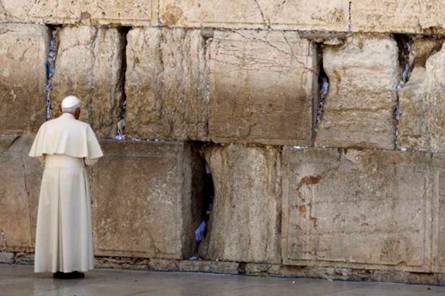Fr Bernard Healy
The Notebook
I was lucky enough to spend a few days in Jerusalem this spring. Whilst there, I was able to visit a site sacred to our Jewish brethren, namely the Western (or Wailing) Wall. The Wall stands as a visible reminder of the destruction of the Jewish Temple by the Romans in 70AD and is an extraordinary place of prayer and pilgrimage. Having visited the aboveground part of the Wall, I also took a guided tour underneath present-day Jerusalem in order to see the excavations that have uncovered even more of the structure, getting down as far as what was street-level at the time of Christ.
My guide was an American rabbi who explained the history of the place. The Wall wasn’t holy in itself. It wasn’t part of the Temple, but was a retaining wall built by King Herod the Great around the Temple Mount. Its importance lies in the fact that it is as close as the Jewish people can get to the holiest place in their tradition, the site of the Temple where God made His home.
Tradition also associates the Temple Mount with a key place in the scriptures, namely Mount Moriah, where Abraham was willing to sacrifice his son Isaac in the 22nd chapter of Genesis. Christianity and Judaism both recognise Abraham as being, in the words of the Mass, ‘our father in faith,’ but what does this unsettling bible passage say about Abraham and about God? The rabbi explained it as follows: whilst the neighbouring nations practiced human sacrifice, Mount Moriah was the place where God revealed a fundamental truth to Abraham. If he wished to worship God, the right way to do that was by loving his son rather than sacrificing him. Judaism, the rabbi said, was thus established as a religion of life!
In later centuries this would be one of the defining cultural distinctions between Judaism and the culture of the Roman Empire. Whilst the Roman paterfamilias had the power of life and death over his children, and sickly new-borns could be left to die, the Jewish ethos of life meant that families recognised a God-given responsibility to care for the weak and would not countenance infanticide.
Attention
This trip to the foot of the Temple Mount drew my attention to two foundation stones of the Christian faith. The Jewish ethos of life was inherited by the early Christians who bore witness to the sanctity of life and the duty of charity by rescuing infants that had been abandoned according to the Roman custom. Secondly, I’d never quite appreciated how the faith of Abraham also carried with it a message about fatherhood. The message that Abraham received about how to be a father was a necessary preparation for Christ’s showing us how God is our compassionate Father.
An unforgettable event in Jerusalem is the beginning of Sabbath. Every Friday, as day slips into evening, a siren sounds throughout the city letting everyone know that Sabbath is near. In the Jewish areas, the streets are full of families rushing on foot towards their synagogue or the Western Wall to joyfully welcome the Sabbath with prayer, dancing and song. It’s notable how hands-on fathers are in helping their sons learn the ritual of Jewish prayer.
It would be a beautiful thing in Ireland if we were so keen and joyful in our observance of Sunday, and if we had a stronger culture of both fathers and mothers enthusiastically teaching the traditions of our faith.
IN JERUSALEM
One can also visit the top of the Temple Mount, but it is under the strict control of Islamic authorities. All non-Muslim prayer is strictly banned, with visitors forbidden to enter with bibles, prayer books or any religious items. Most Orthodox Jews won’t visit for fear of accidentally stepping on the location of the Holy of Holies, the place where the Ark of the Covenant was kept. In the time of the Temple, only the High Priest could enter this place, and then only once a year. A story is told about the 19th Century Jewish nobleman Baron Moses Montefiore. He dearly wanted to visit the Temple Mount, but didn’t want to offend against tradition. In order to square the circle, it is said that he made his visit in a sedan chair, carried by Muslim porters, so he could say for certainty he visited the Temple Mount but did not set foot on holy ground.


 Pope Benedict XVI praying at the Wailing Wall
Pope Benedict XVI praying at the Wailing Wall 